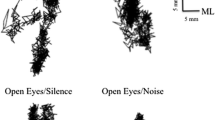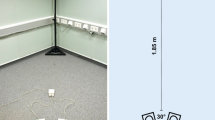Abstract
Postural control is known to be the result of the integration and processing of various sensory inputs by the central nervous system. Among the various afferent inputs, the role of auditory information in postural regulation has been addressed in relatively few studies, which led to conflicting results. The purpose of the present study was to investigate the influence of a rotating auditory stimulus, delivered by an immersive 3D sound spatialization system, on the standing posture of young subjects. The postural sway of 20 upright, blindfolded subjects was recorded using a force platform. Use of various sound source rotation velocities followed by sudden immobilization of the sound was compared with two control conditions: no sound and a stationary sound source. The experiment showed that subjects reduced their body sway amplitude and velocity in the presence of rotating sound compared with the control conditions. The faster the sound source was rotating, the greater the reduction in subject body sway. Moreover, disruption of subject postural regulation was observed as soon as the sound source was immobilized. These results suggest that auditory information cannot be neglected in postural control and that it acts as additional information influencing postural regulation.




Similar content being viewed by others
Notes
Heel-to-toe position.
References
Agaeva MY, Altman YA (2005) Effect of a sound stimulus on postural reactions. Hum Physiol 31(5):511–514
Aytekin M, Moss CF, Simon JZ (2008) A sensorimotor approach to sound localization. Neural Comput 20(3):603–635
Chiari L, Dozza M, Cappello A, Horak FB, Macellari V, Giansanti D (2005) Audio-biofeedback for balance improvement: an accelerometry-based system. IEEE Trans Biomed Eng 52(12):2108–2111
Chun MM, Johnson MK (2011) Memory: enduring traces of perceptual and reflective attention. Neuron 72(4):520–535
Davis JR, Carpenter MG, Tschanz R, Meyes S, Debrunner D, Burger J, Allum JH (2010) Trunk sway reductions in young and older adults using multi-modal biofeedback. Gait Posture 31(4):465–472
Deviterne D, Gauchard GC, Jamet M, Vançon G, Perrin PP (2005) Added cognitive load through rotary auditory stimulation can improve the quality of postural control in the elderly. Brain Res Bull 64(6):487–492
Dozza M, Horak FB, Chiari L (2007) Auditory biofeedback substitutes for loss of sensory information in maintaining stance. Exp Brain Res 178(1):37–48
Easton R, Greene AJ, DiZio P, Lackner JR (1998) Auditory cues for orientation and postural control in sighted and congenitally blind people. Exp Brain Res 118(4):541–550
Era P, Heikkinen E (1985) Postural sway during standing and unexpected disturbance of balance in random samples of men of different ages. J Gerontol 40(3):287–295
Era P, Schroll M, Ytting H, Gause-Nilsson I, Heikkinen E, Steen B (1996) Postural balance and its sensory-motor correlates in 75-year-old men and women: a cross-national comparative study. J Gerontol Ser A-Biol Sci Med Sci 51(2):M53–M63
Gerzon MA (1985) Ambisonics in multichannel broadcasting and video. J Acoust Eng Soc 33(11):859–871
Juntunen J, Ylikoski J, Ojala M, Matikainen E, Ylikoski M, Vaheri E (1987) Postural body sway and exposure to high-energy impulse noise. Lancet 330(8553):261–264
Kanegaonkar R, Amin K, Clarke M (2012) The contribution of hearing to normal balance. J Laryngol Otol 126(10):984
Kellogg WN (1962) Sonar system of the blind new research measures their accuracy in detecting the texture, size, and distance of objects “by ear”. Science 137(3528):399–404
Kelly JW, Riecke B, Loomis JM, Beall AC (2008) Visual control of posture in real and virtual environments. Percept Psychophys 70(1):158–165
Makous JC, Middlebrooks JC (1990) Two-dimensional sound localization by human listeners. J Acoust Soc Am 87:2188
Maurer C, Mergner T, Peterka R (2006) Multisensory control of human upright stance. Exp Brain Res 171(2):231–250
Merer A, Ystad S, Kronland-Martinet R, Aramaki M (2008) Semiotics of sounds evoking motions: categorization and acoustic features. In: Springer (ed) Computer Music Modeling and Retrieval, Sense of Sounds, pp 139–158
Mergner T, Schweigart G, Maurer C, Blümle A (2005) Human postural responses to motion of real and virtual visual environments under different support base conditions. Exp Brain Res 167(4):535–556
Palm HG, Strobel J, Achatz G, von Luebken F, Friemert B (2009) The role and interaction of visual and auditory afferents in postural stability. Gait Posture 30(3):328–333
Park SH, Lee K, Lockhart T, Kim S et al (2011) Effects of sound on postural stability during quiet standing. J Neuroeng Rehabil 8(1):1–5
Perrin PP, Gauchard GC, Perrot C, Jeandel C (1999) Effects of physical and sporting activities on balance control in elderly people. Brit J Sport Med 33(2):121–126
Raper S, Soames R (1991) The influence of stationary auditory fields on postural sway behaviour in man. Eur J Appl Physiol O 63(5):363–367
Redfern MS, Yardley L, Bronstein AM (2001) Visual influences on balance. J Anxiety Disord 15(1):81–94
Riley MA, Baker AA, Schmit JM (2003) Inverse relation between postural variability and difficulty of a concurrent short-term memory task. Brain Res Bull 62(3):191–195
Soames R, Raper S (1992) The influence of moving auditory fields on postural sway behaviour in man. Eur J Appl Physiol O 65(3):241–245
Stins JF, Roerdink M, Beek PJ (2011) To freeze or not to freeze? Affective and cognitive perturbations have markedly different effects on postural control. Hum Mov Sci 30(2):190–202
Stoffregen TA, Hove P, Bardy BG, Riley M, Bonnet CT (2007) Postural stabilization of perceptual but not cognitive performance. J Motor Behav 39(2):126–138
Stoffregen TA, Villard S, Kim C, Ito K, Bardy BG et al (2009) Coupling of head and body movement with motion of the audible environment. J Exp Psychol Hum Percept Perform 35(4):1221
Tanaka T, Kojima S, Takeda H, Ino S, Ifukube T (2001) The influence of moving auditory stimuli on standing balance in healthy young adults and the elderly. Ergonomics 44(15):1403–1412
Vuillerme N, Nafati G (2007) How attentional focus on body sway affects postural control during quiet standing. Psychol Res 71(2):192–200
Vuillerme N, Vincent H (2006) How performing a mental arithmetic task modify the regulation of centre of foot pressure displacements during bipedal quiet standing. Exp Brain Res 169(1):130–134
Wenzel EM, Arruda M, Kistler DJ, Wightman FL (1993) Localization using nonindividualized head-related transfer functions. J Acoust Soc Am 94(1):111–123
Author information
Authors and Affiliations
Corresponding author
Rights and permissions
About this article
Cite this article
Gandemer, L., Parseihian, G., Kronland-Martinet, R. et al. The influence of horizontally rotating sound on standing balance. Exp Brain Res 232, 3813–3820 (2014). https://doi.org/10.1007/s00221-014-4066-y
Received:
Accepted:
Published:
Issue Date:
DOI: https://doi.org/10.1007/s00221-014-4066-y




